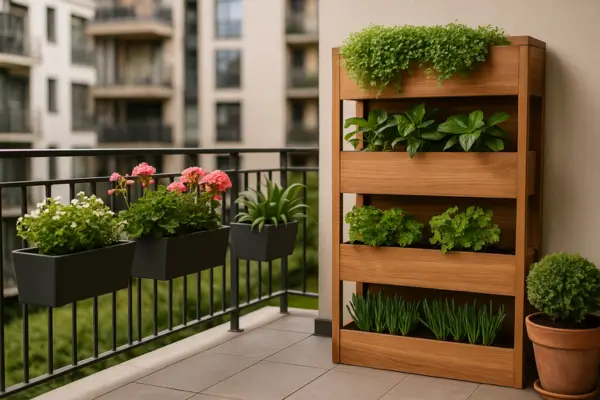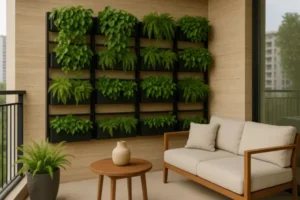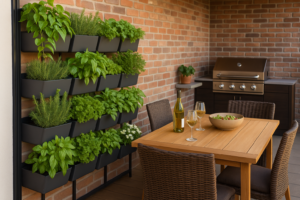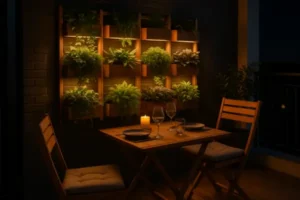How modular gardens increase property value in urban areas is a topic that’s gaining attention for a simple reason: people are changing the way they see outdoor space. In cities where every square foot counts, adding green design isn’t just a visual choice—it’s a smart one.
Modular gardens offer a flexible way to liven up walls and balconies. They are easy to install, require no major renovations, and bring a strong sense of comfort to small spaces. And when someone walks into a home and sees this type of greenery, it leaves a lasting impression.
We’ll break down how these systems affect property values, what urban buyers are really looking for, and why this simple upgrade could be worth more than you might think.
How Modular Gardens Increase Property Value in Urban Areas
When people think about boosting property value, their minds often go to renovations, paint jobs, or new appliances.
But in many urban areas, how modular gardens increase property value in urban areas is becoming part of that conversation. These green setups are quietly shifting how a space is perceived and priced.
These gardens are more than a trend. Real estate agents and developers have noticed that homes with modular greenery tend to stand out in listings. They photograph better, attract more interest during showings, and often feel more welcoming.
This creates what experts call “perceived value”—the emotional connection buyers form when they walk into a space that feels fresh, alive, and well cared for.
In competitive markets, small visual and functional upgrades can tilt the scale. A modular garden on a balcony or courtyard makes the space feel more useful and complete.

Buyers imagine themselves enjoying that spot—having coffee, relaxing, or hosting a guest. That feeling directly influences their decision-making and can justify a higher offer.
What makes this strategy especially appealing is its low cost compared to traditional renovations. Installing a modular vertical garden doesn’t require knocking down walls or hiring a team of contractors. In many cases, a modular system can be installed in a weekend with basic tools.
For urban landlords or owners looking to rent or sell quickly, the return on investment is very real. Listings with appealing outdoor features—especially vertical green systems—often spend less time on the market and receive more competitive bids.
It’s a practical improvement that also speaks to lifestyle, which matters more than ever in dense urban settings.
What Urban Buyers Are Really Looking For
Urban buyers are used to compromise. They know they won’t get a yard or a big porch. What they want instead is a home that feels thoughtful—something that uses space well and offers a bit of calm in the middle of the city.
Modular gardens fit perfeitamente nesse desejo. They don’t take up much space, but they transform how a property is experienced.
Even small balconies or corners can be turned into places that feel complete. Buyers walk into these homes and instantly notice when an outdoor space has been given attention. It signals that the rest of the home likely follows that same care.
Design That Looks Intentional
When people walk through a property, they notice how things are arranged. A modular garden with clean lines and a tidy layout shows planning and taste. It doesn’t need to be fancy—just enough to show intention.
That’s one of the clear examples of how modular gardens increase property value in urban areas during a visit.
Just a row of herbs in matching planters or a simple green wall with healthy leaves already sets the tone. A well-designed garden feels like part of the home—not something added later.
It helps potential buyers imagine themselves using that space, whether for morning coffee or reading at sunset.
That emotional connection often weighs more than price or square footage. It’s about the experience the property offers.
Low Effort, High Reward
Buyers also think about upkeep. Nobody wants a feature that looks great on day one but becomes a hassle later. Modular systems solve this because they’re simple. They require very little water, no complex tools, and can be adjusted easily if plants need more light or space.
For busy people, this is key. They want the feeling of greenery without adding another chore to their week. When a garden looks good and feels manageable, it becomes a plus—not a burden.
That balance—between charm and practicality—is exactly what today’s buyers are hunting for. It’s not about luxury. It’s about making the most of what you have in a way that feels real.
How Property Investors Use Modular Gardens for Quick Value Gains
In real estate, timing and presentation matter. Especially in urban areas, where apartments often look alike and move fast, the details can shape the deal.
Modular gardens have quietly become one of the easiest ways for investors to add value without touching the structure or layout of a unit.
You don’t need a big budget to create something memorable. These vertical systems change how a property feels, not just how it looks. And that feeling often leads to faster offers—and better numbers.
Why Modular Gardens Work for Small-Scale Investors
Most small investors don’t have the time or money for major renovations. They’re looking for quick wins that improve listing photos and create a stronger first impression. Modular gardens do exactly that.
- They don’t require permits
- They don’t damage walls or floors
- They can be installed in just a few hours
These features are ideal for flippers, landlords, and short-term rental hosts. The garden becomes a simple tool that adds freshness and character, especially in places that might otherwise feel cold or generic.
Visual Impact and Marketing Power
Photos are often the first thing buyers or renters see. A splash of greenery on a balcony or beside a window adds contrast and warmth. It breaks the monotony of white walls and gives people something to remember.
Common placements include:
- Wall-mounted herb or flower frames on balconies
- Compact freestanding systems near natural light sources
- Small vertical units near entryways or in shared building spaces
For rental properties, this creates a reason to slightly raise the monthly price—because the apartment feels more complete. It’s not just about square meters. It’s about perceived lifestyle. And in busy markets, that’s what moves units faster.
Modular gardens have become part of the marketing package. You’ll see them in listing photos, on social media reels, and even mentioned during walkthroughs. They make the space stand out, which is often all that’s needed to close the deal.
Types of Modular Garden Designs That Work Best in Cities
Not every modular garden works well in an urban setting. The best designs are the ones that solve a space problem and add visual balance without making things feel cluttered.
In city apartments or condos, where room is limited, every element needs to serve a purpose—and fit the rhythm of daily life.
Vertical Wall Panels
These are probably the most popular option for city dwellers. They attach directly to walls or balcony railings and can hold herbs, flowers, or even small vegetables.
They’re great for adding life to narrow spaces without taking up any floor area. Many people use them near outdoor seating areas to create a softer, more relaxing backdrop.
Freestanding Tiered Systems
These modular units stand on their own, often on wheels or short legs, and are ideal for renters or those who can’t drill into walls. They work well in corners, near windows, or on rooftops. The tiered design lets you plant multiple layers without blocking light.
Hanging Garden Frames
Lightweight and mobile, these designs are perfect for renters or people living in temporary spaces. They can hang from hooks or frames and be removed or relocated easily. While smaller, they’re great for adding texture and movement to the layout.
In every case, the trick is to balance function and beauty. Overloading a system with plants can make it hard to manage. But picking a few well-chosen varieties—and organizing them by height, color, or season—creates a clean, thoughtful look that fits the urban lifestyle.
How Modular Gardens Affect Buyer Emotions During Property Visits
Real estate choices are often made on feeling before logic. A person steps into a home and, almost instantly, senses if the place feels right.
Understanding how modular gardens increase property value in urban areas starts with recognizing this kind of reaction. They play a quiet but meaningful part in shaping that first impression—especially in urban properties where charm can be hard to find.
When there’s greenery in a space—on a wall, balcony, or even entryway—it brings in warmth. It makes a hard-edged apartment feel more relaxed. That change in tone can turn a short visit into a memorable one.
The Emotional Weight of Small Details
Modular gardens don’t shout for attention, but they influence how people feel. A green wall softens the backdrop. A few hanging herbs add a scent that makes the space more inviting. These quiet touches slow buyers down and give them a reason to linger.
During a tour, small design choices shape the mood. A vertical garden near the entrance sets a welcoming tone from the start.
One on the balcony pulls visitors outside, encouraging them to imagine how they’d use that corner—maybe for coffee, reading, or late-evening conversations.
And that pause? That’s what stays with them. Buyers might not remember every square foot, but they will remember the space that made them feel at home.
Guiding the Flow and Feeling of a Visit
Well-placed plants don’t just look good—they guide the tour. A vertical setup near a window can direct attention toward natural light or a pleasant view. A small panel on a plain wall can turn an overlooked corner into a feature.
Some layouts feel flat or cold until greenery enters the scene. A modular garden brings contrast, rhythm, and a hint of nature to spaces that need personality. And when multiple units look similar in layout and price, this emotional layer often becomes the deciding factor.
Buyers may not say it out loud, but they recognize when a space feels balanced and lived-in. That subtle sense of intention often moves a home from maybe to yes.
Why Modular Gardens Are Easy to Maintain in Urban Homes
In cities, time and space are always limited. That’s why many people skip adding greenery—they assume it will take too much work. But modular gardens were built for exactly this kind of life. They’re made to bring the feeling of a garden without the stress of maintaining one.
These systems are compact, smart, and flexible. Whether you live in a small studio or a high-rise apartment, they adapt to your layout and schedule. And most importantly, they’re designed so anyone can manage them—even without gardening experience.
Designed for Simplicity
One of the biggest advantages of modular gardens is how easy they are to handle. Most models come with built-in trays for watering and drainage, meaning less mess and fewer problems like root rot.
The sections can be taken apart and rearranged without tools, which is especially useful if you need to move things around for sunlight or space.
- Modular = manageable: You don’t need to water everything at once. Each section can be cared for individually, making the process feel lighter and more flexible.
- Built-in drainage: No guessing if you overwatered. These systems are made to drain excess moisture and protect your walls or floors from damage.
Even cleaning is simple. A quick wipe-down with a damp cloth or a rinse with mild soap is enough. No heavy scrubbing, no seasonal overhauls.
Urban-Friendly and Flexible
Traditional gardens are rooted in one place, literally. Modular gardens, on the other hand, move with you. If you rent, you can take them when you leave. If you redecorate, they shift with the new layout.
This kind of mobility makes them ideal for people who like to update their space without starting from scratch.
Another key point is sunlight management. Some balconies get strong sun all day, while others are shaded. With modular systems, you can rotate plants, change locations, or add shade covers without replanting everything. It’s a system that works with your space, not against it.
Because they’re lightweight and often freestanding or wall-mounted, there’s no need to drill deep or hire help. This makes them especially appealing for apartment dwellers and older adults who want greenery without the physical effort of a full garden.
In the end, modular gardens offer something rare in urban life: a way to bring nature into your routine without disrupting it. They give the impression of care and style, with far less effort than most people expect.
Creating Microclimates with Modular Gardens in Urban Spaces
Urban homes, especially in apartments surrounded by glass and hard surfaces, heat up quickly. Long afternoons with direct sun can turn a balcony into a place no one wants to be.
But modular gardens offer a surprisingly effective way to change that. By placing plants strategically, you can shift the temperature and atmosphere in small spaces—without any major changes.
This effect is known as creating a microclimate: a small area where temperature, humidity, and light behave differently from the space around it. In a dense city, this can turn a hot balcony or a dull corner into a usable, pleasant retreat.
How Plants Influence Comfort Levels
Plants aren’t just for decoration. When grouped together in a modular system, they start to influence the air and light around them. Broad leaves act as natural filters.
Moist soil increases humidity slightly, making dry areas feel softer. The shade they cast protects surfaces from becoming too hot.
Here’s what this means in practice:
- Leaf coverage reduces surface heat: Direct sun hitting bare tiles or walls raises temperatures fast. A layer of greenery breaks that exposure, lowering the heat buildup on balconies and near windows.
- Moisture helps cool the air: As plants release water through evaporation, the air around them becomes less harsh. This creates a small buffer zone—noticeably cooler on summer afternoons.
In simple terms, a few vertical panels filled with the right plants can shift the feel of a space by several degrees. You might still feel the heat, but it won’t hit with the same intensity.
Final Thoughts
Modular gardens bring a fresh sense of purpose to small spaces in the city. They create spots that feel more alive, more inviting, and easier to enjoy—without needing big changes.
They improve visual appeal and enhance the way people interact with a space. That’s exactly how modular gardens increase property value in urban areas—by adding qualities that buyers and renters instantly recognize as meaningful.
Even a simple green wall can shift the mood of a place. It adds texture, rhythm, and balance—details that often stay in people’s memory after a visit. These quiet touches can influence decisions and leave a lasting impression.




